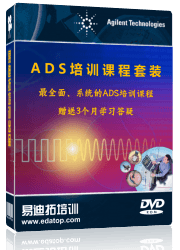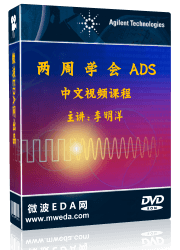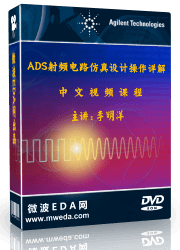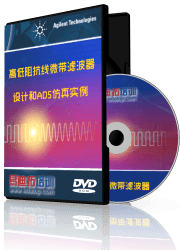- 易迪拓培训,专注于微波、射频、天线设计工程师的培养
Ferrite Beads at high frequency
Looking at the ferrite beads that I could find, a few questions:
1. Are ferrite beads used a chokes at high freq. like 4 GHz and above i.e. are they available at all at that frequency?
2. If not, then when chip inductors are used as RF chokes at higher freq., most manufacturers do not provide the impedance ( R and XL) characteristics for chip inductors. All you know is the SRF. Then, how do we pick the right chip inductor?
3. Also, is it then preferred to have a resistor in series with the chip inductor to emulate(for the lack of a better word) a ferrite bead RF choke?
I'd appreciate any thoughts on the same.
Thanks.
1. -3.: Look at "GHz" and "High GHz" ferrite bead series from Murata.
Most manufacturers give L and Q over frequency, so you can well calculate the impedance.
a ferrite bead can be thought of as a very lossy inductor, or inductor with very low q. U want such a thing in a power supply line, for instance, because u do NOT want to form banpass filters along a DC bias line. How? Well if u put high q inductors every 2" along a line....when your frequency is such that 2" is around a half wavelength, you have actually formed a bandpass response..which will readily LET the microwaves by th einductors.
If they are lossy inductors, this does not happen, because even IF there were a banpass, its loss would be 30 dB or so.
But ferrites are...just a mash of iron type junk. the composition, grain size, binding material, all causes them to work well at some frequencies, and poorly at others.
If you were interested in 4 Ghz leakage, u would want a ferrite bead that had resistive loss at 4 ghz, maybe peaking at 4.5 ghz, so u have to slog thru the manufacturers data sheets. If by ferrite bead, u mean surface mount chip....that is easier, there will be easy to read test charts on the data sheet. U will find most ferrite beads optimized for << 1` GHz
Thanks a ton for the replies.
At the end of another search after reading the replies, I have come across the following:
[URL="http://www.ferroxcube.com/prod/assets/MLP.htm"]http://www.ferroxcube.com/prod/assets/MLP.htm[/URL
http://www.ferroxcube.com/prod/assets/MLS.htm
http://www.ferroxcube.com/prod/assets/MLN.htm
The data for the first few parts in MLN and MLP series is shown only upto 1 GHz. Is it a good idea to test it out? or is it implicit that ferrite beads are not used/optimized above 1 GHz as biff44 pointed out?
I have also looked at the Coilcraft inductors and came across:
http://www.coilcraft.com/4310lc.cfm
How is this working as a wide band RF choke? The impedance vs freq. graph shows a peak below 1000 MHz. So I am unable to understand how this will work up to 6 GHz.
Am I missing something here?
Thanks.
Ferrite beads are typically inserted on WIRES, to achieve stability with RF transistors at up to UHF. Above say 1 GHz, no wires are used but stripline or waveguide lines. Also, RF transistors with Fc >3 GHz can oscillate above the desired frequency range. At >1 GHz, MMICs are preferred and such devices are designed to be stable, without ferrite beads (no wires to put on either).
At >1 GHz, most active devices are installed in shielded enclosures that can and do behave as unwanted waveguides and offer feedback to cause instability. Instead of ferrite beads flat patches made of microwave absorbers are used, glued to sensitive places to suppress stray oscillations.
As previously said, only special types are good for the high GHz range, the shown apparently aren't.
The Murata BLM15g/BLM18G types are said to work upto 6 GHz, unfortunately there analyzer dien't cover the range above 3 GHz, but you can estimate that they are at least a lot better than the regular stuff.

申明:网友回复良莠不齐,仅供参考。如需专业帮助,请学习易迪拓培训专家讲授的ADS视频培训课程。
上一篇:what is the broadside angle for dipole antenna array?
下一篇:cosimulation ads (choose view of simulation)
ADS濠电偞鍨堕幖鈺呭储娴犲鍑犻柛鎰典簼閸犲棝鏌涢埄鍐х繁闁哄棎鍎甸弻娑㈠煛閸愮偓鏁銈嗘煥鐎氭澘顕i鈶╂瀻闁瑰瓨姊归悡锟� | More...
 国内最全面、最专业的Agilent ADS培训课程,可以帮助您从零开始,全面系统学习ADS设计应用【More..】
国内最全面、最专业的Agilent ADS培训课程,可以帮助您从零开始,全面系统学习ADS设计应用【More..】
- Agilent ADS教学培训课程套装
- 两周学会ADS2011、ADS2013视频教程
- ADS2012、ADS2013射频电路设计详解
- ADS高低阻抗线微带滤波器设计培训教程
- ADS混频器仿真分析实例视频培训课程
- ADS Momentum电磁仿真设计视频课程
- ADS射频电路与通信系统设计高级培训
- ADS Layout和电磁仿真设计培训视频
- ADS Workspace and Simulators Training Course
- ADS Circuit Simulation Training Course
- ADS Layout and EM Simulation Training Course
- Agilent ADS 内部原版培训教材合集








